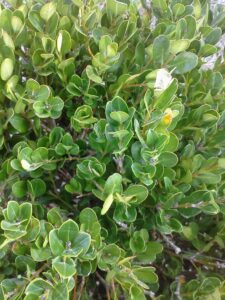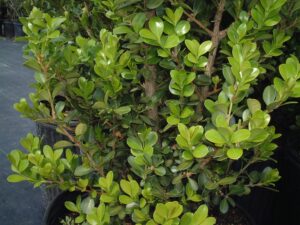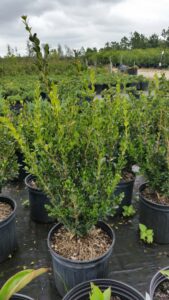Growing Boxwood Shrubs
in the Northeast Florida Landscape
If you ever have the misfortune to hear me talk for any length of time about plants, ( which you would if you ever run into me at our nursery site here in North Florida ) you will inevitably hear me say this one thing about almost every plant you could ask about. There are different kinds of ….. this one here……
There are different varieties of all types of plants, each variety and each selection or ‘cultivar’ within that variety may have its own unique growth habits, mature heights and widths, water needs, drought resistance, disease resistance, insect tolerance, the list goes on. They are not the same plant because they share the same general (genus) name and the same general appearance although they are extremely similar. With the slight variations in form, leaf color, texture, and size that make each species and cultivar unique other less noticeable changes can occur behind the scenes that can affect all sorts of things including its overall growth habit and mature size, leaf arrangement, natural shape, disease resistance, drought tolerance, insect tolerance, heat and humidity tolerance etc. Each cultivar is unique within that plant Species and each species is unique within that Genus. It is those subtle changes in leaf form and arrangement etc. that guide botanists in determining what plant family each plant belongs to and how they decide to group those subtle differences together that make up our current binomial plant classification system.
selection or ‘cultivar’ within that variety may have its own unique growth habits, mature heights and widths, water needs, drought resistance, disease resistance, insect tolerance, the list goes on. They are not the same plant because they share the same general (genus) name and the same general appearance although they are extremely similar. With the slight variations in form, leaf color, texture, and size that make each species and cultivar unique other less noticeable changes can occur behind the scenes that can affect all sorts of things including its overall growth habit and mature size, leaf arrangement, natural shape, disease resistance, drought tolerance, insect tolerance, heat and humidity tolerance etc. Each cultivar is unique within that plant Species and each species is unique within that Genus. It is those subtle changes in leaf form and arrangement etc. that guide botanists in determining what plant family each plant belongs to and how they decide to group those subtle differences together that make up our current binomial plant classification system.
Boxwood shrubs are no exception to that general plant rule. And nowhere in the Florida landscape are those binomial classifications that are there to help guide us more ignored than plants constantly just labeled and sold as BOXWOOD in our local nurseries and garden centers. Ok, ok Loropealums might be worse, but at least they are labeled when you buy them. We may quickly forget which one we have only to mismatch them in the garden later, but we had an idea of which one we were purchasing at the time!
Not only does leaf form and color vary from one boxwood to the next, cold tolerance, heat and humidity tolerance, and growth habit and height vary as well. Lets take a look at the Boxwood ( Buxus) genus and species below and the cultivars within those species with a brief description of the subtle changes we may not notice at a glance, but will notice over time when they are doing different things at different times, or the colors are just a bit different etc.
Boxwood / Buxus microphylla ( Little Leaf Boxwood )
Cold Hardiness: Little Leaf Boxwood or Boxwood Microphylla is a little grown boxwood variety that is cold tolerant to 10 degrees F.
Growth Rate: Extremely slow growing species
Growth Height: Eventually reaching 3-4 ft in Height and Width
Notes: Rarely grown commercially due to its slow growth habit
http://hort.ufl.edu/database/documents/pdf/shrub_fact_sheets/buxmica.pdf
Boxwood / Buxus microphylla ‘japonica’ ( Japanese Little Leaf Boxwood ) 
Cold Hardiness: New growth of the foliage may turn bronzy in colder winters re-greening quickly in spring.
Growth Rate: Much faster than typical to that of the species
Growth Height: Japanese Boxwood eventually reaching 6 ft in Height and 3-4 ft wide.
Notes: This Variety is perfect for Northeast Florida’s heat and humidity and thrives in our subtropical climate. The most commonly grown and sold Boxwood for our area landscapes.
Boxwood / Buxus sempervirens ( Common or American Boxwood )
Cold Hardiness: Extremely cold tolerant species growing in areas with cold winter temperatures, tolerates down to -10 degrees F.
Growth Rate: Slow
Growth Height: Common, or American Boxwood shrubs grow slowly but will reach heights of 15-20 ft eventually.
Notes: Although its common name would give you the idea that most of the boxwood you run across would in the garden would be Buxus sempervirens. But remember, these common names apply for anywhere and everywhere they are used not just for Florida. And when it comes to Florida , these are not so common after all. In fact, most of the time they come with a recommendation for only planting in zone 8 and above which excludes much of Florida other than North Florida and areas of the panhandle. I avoid planting Common or American boxwood in low areas or areas that remain moist with heavy rainfalls.
Boxwood / Buxus Suffruiticosa ( Edging or English Boxwood )
Cold Hardiness: Extremely cold tolerant species growing in areas with cold winter temperatures to -15 degrees F.
Growth Rate: Extremely slow growing – harder to find in Florida not often grown.
Growth Height: Edging or English boxwood grow to 3ft high and wide
Notes: Foliage on English boxwood stay dense and compact making a nice tight hedge for formal garden settings or house foundations, garden fences etc.
Boxwood / Buxus Sinica var. Insularis ‘Wintergreen’ and WinterGem’ ( Korean Boxwood ) Formerly classified as Buxus microphylla var. Koreana
Cold Hardiness: Extremely cold tolerant species growing in areas with cold winter temperatures to -15 degrees F.
Growth Rate: Extremely slow growing
Growth Height: 3-5 ft high and 4-6′ ft wide
Notes: Foliage ( mainly new growth areas) on Wintergreen and Winter Gem turns bronzy orange to red in the fall / winter season when temperatures begin to cool. Darker green, slightly more narrow leaves than microphylla.
Full sun / Tolerates shade
moist well drained soils
Hardy Boxwood selections for Northeast Florida Landscapes

